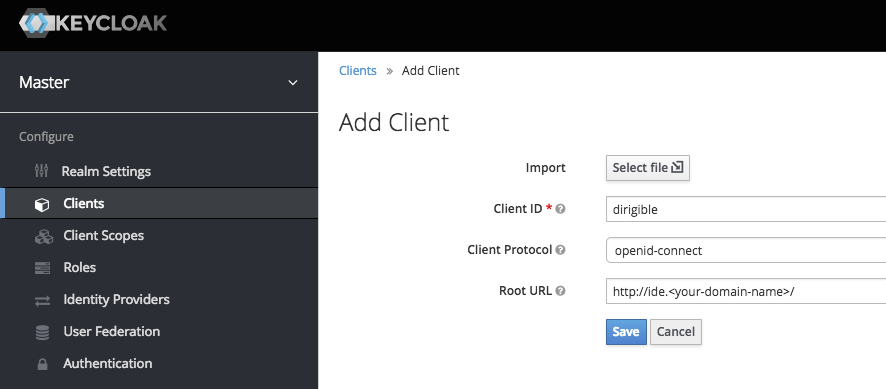Kubernetes, Keycloak, PostgreSQL & Dirigible
This article is dedicated to the "production-ready" setup of Eclipse Dirigible in a Kubernetes cluster.
Overview
In this article we are going to use Kubernes cluster, Keycloak IAM and PostgreSQL database for setting up a productive Eclipse Dirigible development platform. The target Kubernetes deployment is shown bellow:

Kubernetes
is an open source system for automating deployment, scaling, and management of containerized applications in a cluster environment. You can read more about Kubernetes here.
Keycloak
is an open source Identity and Access Management system for applications and services. You can read more about Keycloak here.
PostgreSQL
is a powerful open source object-relational database system with over 30 years of active development that has earned it a strong reputation for reliability, feature robustness, and performance. You can read more about PostgreSQL here.
Eclipse Dirigible
is a Cloud Development Platform providing development tools and runtime environment. It supports full development life-cycle of on-demand applications by leveraging in-system programming models and rapid application development techniques. You can read more about Dirigible here.
Prerequisites
In this article we assume that you have already running productive Kubernetes Cluster and configured kubectl for it. If you don't have such, you can create one by using the GKE or the open-source Gardener project. Also we need a configured Helm (The Kubernetes Package Manager), if you don't have it, you can follow this installation guide.
Kubernetes Certificate Management Controller
cert-manager is a native Kubernetes certificate management controller. It can help with issuing certificates from a variety of sources, such as Let’s Encrypt, HashiCorp Vault, or a simple signing keypair. You can read more about the cert-manager here.
helm install --name cert-manager --namespace kube-system stable/cert-manager
We are going to use cert-manager for issuing certificates for our access points to the Keycloak Admin Console and Eclipse Dirigible IDE.
Namespaces and ClusterIssuer
auth.yaml
kind: Namespace
metadata:
name: auth
...
kind: ClusterIssuer
metadata:
name: letsencrypt-production
spec:
acme:
server: https://acme-v02.api.letsencrypt.org/directory
email: <your-email-address>
privateKeySecretRef:
name: letsencrypt-production
http01: {}
Note: For testing purposes it's recommended to use the staging Let's Encrypt server.
The whole YAML is available here. Before creating the Kubernetes resources, you should replace the placeholders with the correct values.
kubectl create -f auth.yaml
Keycloak and PostgreSQL
keycloak.yaml
kind: StatefulSet
metadata:
name: postgres
...
spec:
containers:
- name: postgres
image: postgres
env:
- name: PGDATA
value: "/var/lib/postgresql/data/pgdata"
- name: POSTGRES_USER
value: "keycloak"
- name: POSTGRES_PASSWORD
value: "keycloak"
...
kind: Deployment
metadata:
name: keycloak
...
spec:
containers:
- name: keycloak
image: jboss/keycloak
env:
- name: PROXY_ADDRESS_FORWARDING
value: "true"
- name: DB_VENDOR
value: "postgres"
- name: DB_USER
value: "keycloak"
- name: DB_PASSWORD
value: "keycloak"
- name: DB_ADDR
value: "postgres-jdbc.auth"
- name: KEYCLOAK_USER
value: "admin"
- name: KEYCLOAK_PASSWORD
value: "admin"
...
kind: Ingress
metadata:
name: keycloak
annotations:
ingress.kubernetes.io/ssl-redirect: "true"
kubernetes.io/tls-acme: "true"
certmanager.k8s.io/cluster-issuer: "letsencrypt-production"
kubernetes.io/ingress.class: "nginx"
spec:
tls:
- hosts:
- keycloak.<your-domain-name>
secretName: keycloak-production-letsencrypt
rules:
- host: keycloak.<your-domain-name>
...
Note: The maximum length of the host name (e.g. keycloak.YOUR-DOMAIN-NAME) used for issuing Let's Encrypt certificate is 63 symbols.
The whole YAML is available here. Before creating the Kubernetes resources, you should replace the placeholders with the correct values.
kubectl create -f keycloak.yaml
Dirigible and PostgreSQL
dirigible.yaml
kind: StatefulSet
metadata:
name: postgres
...
spec:
containers:
- name: postgres
image: postgres
env:
- name: PGDATA
value: "/var/lib/postgresql/data/pgdata"
- name: POSTGRES_USER
value: "dirigible"
- name: POSTGRES_PASSWORD
value: "dirigible"
...
kind: StatefulSet
metadata:
name: dirigible
...
spec:
containers:
- name: dirigible
image: dirigiblelabs/dirigible-keycloak
env:
- name: DIRIGIBLE_DATABASE_PROVIDER
value: "custom"
- name: DIRIGIBLE_DATABASE_CUSTOM_DATASOURCES
value: "POSTGRES"
- name: POSTGRES_URL
value: "jdbc:postgresql://postgres-jdbc.dirigible:5432/dirigible"
- name: POSTGRES_USERNAME
value: "dirigible"
- name: POSTGRES_PASSWORD
value: "dirigible"
...
- name: KEYCLOAK_CONFIDENTIAL_PORT
value: "443"
- name: KEYCLOAK_SSL_REQUIRED
value: "none"
- name: KEYCLOAK_CLIENT_ID
value: "dirigible"
- name: KEYCLOAK_REALM
value: "master"
- name: KEYCLOAK_AUTH_SERVER_URL
value: "https://keycloak.<your-domain-name>/auth"
...
kind: Ingress
metadata:
annotations:
ingress.kubernetes.io/ssl-redirect: "true"
kubernetes.io/tls-acme: "true"
certmanager.k8s.io/cluster-issuer: "letsencrypt-production"
kubernetes.io/ingress.class: "nginx"
name: dirigible
namespace: dirigible
spec:
tls:
- hosts:
- ide.<your-domain-name>
secretName: dirigible-certificate
rules:
- host: ide.<your-domain-name>
Note: The maximum length of the host name (e.g. ide.YOUR-DOMAIN-NAME) used for issuing Let's Encrypt certificate is 63 symbols.
The whole list of Eclipse Dirigible environment variables can be found here
The whole YAML is available here. Before creating the Kubernetes resources, you should replace the placeholders with the correct values.
kubectl create -f dirigible.yaml
Add Keycloak Client and Users
Open the Keycloak welcome page (https://keycloak.YOUR-DOMAIN-NAME) and click on the Admin Console, login with admin/admin credentials (see keycloak.yaml).
- Create new client named dirigible
- For the Root URL add Root URL: http://ide.YOUR-DOMAIN-NAME

- Add Client Roles:
- Everyone
- Developer
- Operator
- Create new user

- Assign User's roles from the dirigible client
- Set password from the Credentials tab
- Open the Eclipse Dirigible IDE: http://ide.YOUR-DOMAIN-NAME/ and login with the credentials that were created previously in the Keycloak Admin Console.

The Keycloak documentation can be found here. Also you can find out how to enable Keycloak Social Login with GitHub here.